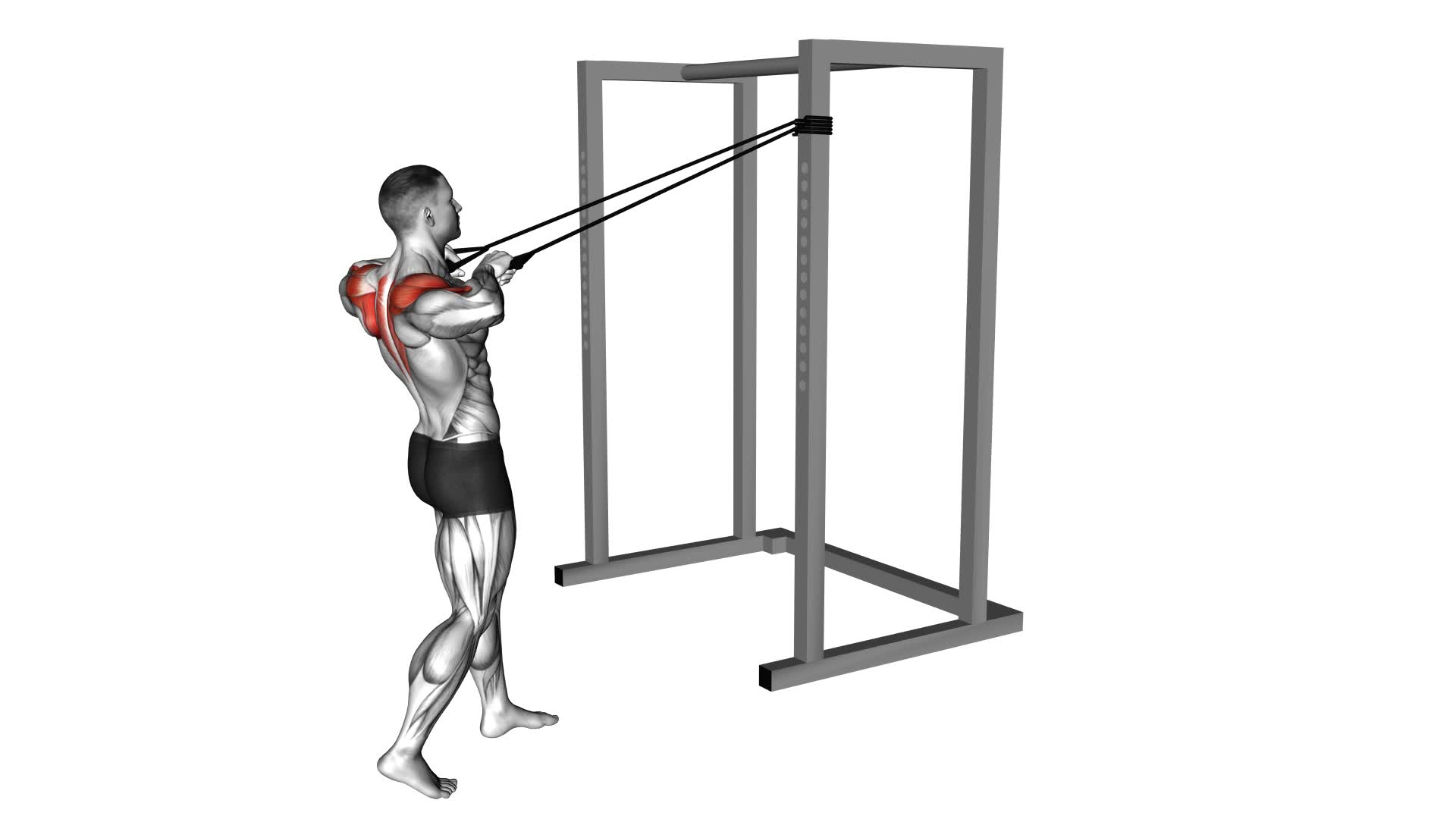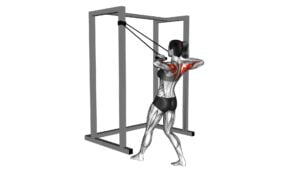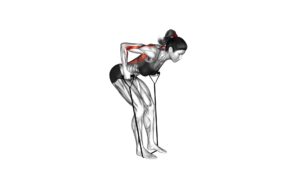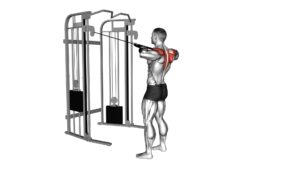Band Standing Rear Delt Row – Video Exercise Guide & Tips

Are you looking to strengthen your rear deltoids? The Band Standing Rear Delt Row is a great exercise to add to your routine.
Watch This Exercise Video
In this video exercise guide, you'll learn the proper form and technique for this exercise, as well as different variations to keep your workouts interesting. Maximize the effectiveness of your workout with our helpful tips.
Avoid common mistakes and incorporate the Band Standing Rear Delt Row into your routine today for stronger, more defined shoulders.
Key Takeaways
- The Band Standing Rear Delt Row strengthens and tones rear deltoid muscles while improving shoulder stability and enhancing posture.
- Proper form and technique for the exercise include keeping the back straight, shoulders down and back, and engaging the core, while avoiding rounding the back or shrugging the shoulders.
- Avoiding common mistakes such as using momentum, maintaining good posture, and controlling the movement can maximize the effectiveness of the exercise.
- Different variations of the Band Standing Rear Delt Row, such as the single arm variation or using resistance bands, can target different muscle groups and add variety to workouts.
Benefits of the Band Standing Rear Delt Row
To maximize your workout, discover the benefits of the Band Standing Rear Delt Row, as it helps strengthen and tone your rear deltoid muscles. This exercise specifically targets the muscles in the back of your shoulders, also known as the rear delts. By incorporating the Band Standing Rear Delt Row into your routine, you can experience numerous benefits.
One of the main benefits of this exercise is improved shoulder stability. As you perform the movement, the resistance from the band challenges your muscles to work harder, increasing their strength and stability. This can help prevent injuries, especially in activities that require shoulder mobility, such as throwing or lifting.
Additionally, the Band Standing Rear Delt Row helps to enhance your posture. By strengthening your rear deltoid muscles, you can counteract the effects of sitting at a desk for long hours or spending too much time hunched over your phone. This exercise promotes proper alignment and helps you stand tall with your shoulders back.
To get the most out of the Band Standing Rear Delt Row, ensure proper form and technique. Start by standing tall with your feet shoulder-width apart and the band securely anchored. Hold the band with an overhand grip and pull your elbows back, squeezing your shoulder blades together. Remember to engage your core and keep a slight bend in your knees for stability.
Incorporating the Band Standing Rear Delt Row into your workout routine can provide you with numerous benefits such as improved shoulder stability and enhanced posture. By following these tips and performing the exercise correctly, you can maximize the effectiveness of the exercise and achieve your fitness goals more efficiently.
Proper Form and Technique for the Exercise
To perform the Band Standing Rear Delt Row with proper form and technique, it's important to focus on correct body positioning and avoid common mistakes.
Keep your back straight, shoulders down and back, and engage your core throughout the exercise.
Avoid rounding your back or shrugging your shoulders, as this can put unnecessary strain on your spine and neck.
Correct Body Positioning
Stand with your feet shoulder-width apart and hold the resistance band with both hands, palms facing down. Proper body positioning is crucial for performing the Band Standing Rear Delt Row exercise effectively.
It helps to maintain shoulder stability and engage the upper back muscles properly. By standing with your feet shoulder-width apart, you create a stable base and ensure proper balance throughout the exercise.
Holding the resistance band with both hands, palms facing down, allows for a secure grip and better control of the movement. This positioning helps to activate the rear deltoids and other upper back muscles, maximizing the effectiveness of the exercise.
Now that you understand the correct body positioning, let's move on to the next section about avoiding common mistakes in order to get the most out of this exercise.
Avoiding Common Mistakes
Once you have mastered the correct body positioning, it's important to focus on avoiding common mistakes to ensure proper form and technique for the Band Standing Rear Delt Row exercise. To help you execute the exercise correctly, here are some common errors to watch out for and tips for proper execution:
- Avoid using momentum: Make sure to control the movement and avoid swinging or jerking your body.
- Keep your back straight: Maintain good posture throughout the exercise to engage your rear delts effectively.
- Squeeze your shoulder blades: As you pull the bands towards your body, focus on squeezing your shoulder blades together to target the rear delts.
By following these tips, you can avoid common mistakes and perform the Band Standing Rear Delt Row with proper form and technique.
Now let's explore different variations of the exercise to add variety to your workout routine.
Different Variations of the Band Standing Rear Delt Row
For more variety and to target different muscles, try incorporating different variations of the Band Standing Rear Delt Row.
By changing up the exercise, you can activate different muscle groups and keep your workouts interesting.
One variation you can try is the Single Arm Band Standing Rear Delt Row. This variation focuses on one side of your body at a time, allowing for greater isolation of the rear delts.
Another variation is the Band Standing Rear Delt Row with Resistance Bands. This variation adds resistance to the exercise, making it more challenging and effective for building strength and muscle. To perform this variation, simply attach resistance bands to a stationary object and hold onto the bands while performing the rowing motion.
Lastly, you can also incorporate the Band Standing Reverse Fly into your routine. This variation targets the rear delts and upper back muscles, helping to improve posture and shoulder stability. To perform the Band Standing Reverse Fly, stand with your feet shoulder-width apart and hold the bands in front of you. Keeping a slight bend in your elbows, raise your arms out to the sides, squeezing your shoulder blades together.
Incorporating these different variations into your workouts will help you engage different muscle groups and achieve a well-rounded upper body workout.
Tips for Maximizing the Effectiveness of the Exercise
To maximize the effectiveness of the Band Standing Rear Delt Row exercise, focus on maintaining proper form and engaging your muscles throughout the entire range of motion. Here are some tips to help you maximize your results and ensure optimal muscle activation:
- Start with the right resistance: Choose a band that provides enough resistance to challenge your muscles without compromising your form. Too light of a band may not engage your muscles effectively, while too heavy of a band may lead to poor form and potential injury.
- Keep your core engaged: Throughout the exercise, focus on engaging your core muscles by pulling your belly button towards your spine. This will help stabilize your body and maintain proper alignment.
- Squeeze your shoulder blades: As you pull the band towards your body, focus on squeezing your shoulder blades together. This will target your rear deltoid muscles and help maximize muscle activation.
Transitioning into the subsequent section about common mistakes to avoid, it's important to be aware of these tips in order to get the most out of your Band Standing Rear Delt Row exercise. By following these guidelines, you can ensure proper form, engage your muscles effectively, and achieve optimal results.
Common Mistakes to Avoid While Performing the Exercise
When performing the band standing rear delt row, it's important to maintain proper form to avoid injury and maximize results.
Avoid using excessive weight, as this can lead to strain on the muscles and joints.
Additionally, be mindful of avoiding jerking movements, as this can reduce the effectiveness of the exercise and increase the risk of injury.
Proper Form Importance
Avoid common mistakes while performing the Band Standing Rear Delt Row exercise by maintaining proper form. Proper form is crucial for the overall effectiveness of the exercise and to ensure the safety of your shoulders. By focusing on proper form, you can maximize muscle activation in your rear delts while minimizing the risk of injury. Here are some key points to keep in mind:
- Importance of shoulder health:
- Maintain a neutral spine and engage your core throughout the exercise to protect your shoulders.
- Avoid excessive shoulder rotation or rounding of the upper back, as it can put unnecessary strain on the shoulder joint.
- Muscle activation:
- Initiate the movement from your shoulder blades, squeezing them together to engage the rear delts.
- Keep your elbows in line with your wrists and avoid using too much momentum or swinging.
- Control and range of motion:
- Control the movement in both the concentric and eccentric phases to fully engage the targeted muscles.
- Aim for a full range of motion, but avoid overstretching or hyperextending at the bottom position.
Avoiding Excessive Weight
Don't overload the exercise by adding too much weight. Using excessive weight can lead to injuries and prevent you from getting the full benefits of the exercise.
When performing the Band Standing Rear Delt Row, it's important to prioritize proper form and technique over the amount of weight you use. Lighter weights can still effectively target and strengthen your rear deltoids without putting excessive strain on your muscles and joints.
By using lighter weights, you can focus on maintaining control throughout the movement, reducing the risk of injuries. It's crucial to listen to your body and start with a weight that allows you to perform the exercise with proper form. This will help you avoid unnecessary strain and maximize the benefits of the exercise.
Transitioning into the next section, it's also important to avoid jerking movements during the exercise.
Avoiding Jerking Movements
To prevent injury and maximize the effectiveness of the Band Standing Rear Delt Row, it's crucial to maintain controlled movements throughout the exercise. Avoiding jerking movements is essential for proper execution and to ensure that you're targeting the correct muscles.
Here are some common jerking mistakes to avoid and the proper execution techniques:
- Don't use excessive momentum to pull the bands towards you. Instead, focus on using your rear deltoids to initiate the movement.
- Avoid rounding your shoulders or arching your back during the exercise. Keep your spine neutral and engage your core for stability.
- Don't rush through the exercise. Take your time to perform each repetition with control and focus on squeezing your shoulder blades together at the top of the movement.
Sample Workout Routine Incorporating the Band Standing Rear Delt Row
Incorporate the Band Standing Rear Delt Row into your workout routine for maximum shoulder development. This exercise targets the rear deltoids, helping to improve posture and strengthen the upper back.
To begin, attach a resistance band to a secure anchor point at chest height. Stand facing the anchor point with your feet shoulder-width apart and knees slightly bent. Grasp the band handles with an overhand grip and extend your arms in front of you at shoulder height. Keeping your core engaged, pull the band towards your chest by squeezing your shoulder blades together. Pause for a moment, then slowly return to the starting position. Aim for 3 sets of 10-12 reps, gradually increasing the resistance as you get stronger.
To modify this exercise, you can perform it seated instead of standing. Sit on a bench or chair with your feet flat on the floor and the band securely anchored behind you. Follow the same movement pattern as the standing version, pulling the band towards your chest while keeping your back straight.
If you're looking for alternative exercises to target the rear delts, consider bent-over dumbbell rows, face pulls, or reverse flyes using dumbbells or cables. These exercises also engage the rear deltoids and can be incorporated into your workout routine for variety and balanced shoulder development.
Remember to always use proper form and start with lighter weights before progressing to heavier loads.
Frequently Asked Questions
How Many Sets and Repetitions Should I Perform for the Band Standing Rear Delt Row?
To determine how many sets and repetitions you should perform for the band standing rear delt row, it's important to consider your fitness goals and fitness level.
Generally, it's recommended to start with 2-3 sets of 10-12 repetitions. However, you can adjust the sets and repetitions based on your personal preferences and the intensity you want to achieve.
Additionally, there are variations of this exercise that you can explore to target your rear deltoids from different angles.
Can I Use Dumbbells or a Cable Machine Instead of a Resistance Band for This Exercise?
Yes, you can use dumbbells or a cable machine instead of a resistance band for the band standing rear delt row. However, there are specific benefits to using a resistance band for this exercise.
The resistance band allows for a greater range of motion and helps to engage the muscles in your rear delts more effectively. Additionally, the band provides constant tension throughout the movement, which can contribute to better muscle activation and growth.
Is It Necessary to Warm up Before Performing the Band Standing Rear Delt Row?
It's important to warm up before performing the band standing rear delt row. Warming up helps to increase blood flow, flexibility, and prepares your muscles for exercise. It also reduces the risk of injury.
When performing the exercise, make sure to maintain proper form and technique. Keep your back straight, engage your core, and squeeze your shoulder blades together as you pull the band towards your body. This helps to target and strengthen your rear deltoid muscles effectively.
What Other Muscles Does the Band Standing Rear Delt Row Target?
The band standing rear delt row is a great exercise that targets not only your rear deltoids but also your upper back muscles. By pulling the bands towards your body, you engage the muscles in your shoulders, upper back, and arms.
This exercise can be modified by using different variations or progressing to heavier resistance bands. It's an effective way to strengthen and tone multiple muscle groups in your upper body.
Can This Exercise Help Improve Posture and Prevent Shoulder Injuries?
Posture correction exercises and shoulder injury prevention exercises are important for maintaining a healthy body.
By targeting the rear deltoids, the band standing rear delt row can help improve your posture and prevent shoulder injuries.
This exercise engages the muscles in your upper back, strengthening them and promoting better alignment.
Incorporating this exercise into your routine can contribute to a stronger upper body and reduce the risk of shoulder problems.
Conclusion
In conclusion, incorporating the band standing rear delt row into your workout routine can provide numerous benefits for your rear deltoids.
By maintaining proper form and technique, you can maximize the effectiveness of the exercise and avoid common mistakes.
Additionally, you can vary the intensity by using different band variations.
Remember to follow these tips and techniques to achieve optimal results and strengthen your rear deltoids effectively.

Author
Years ago, the spark of my life’s passion ignited in my mind the moment I stepped into the local gym for the first time. The inaugural bead of perspiration, the initial endeavor, the very first surge of endorphins, and a sense of pride that washed over me post-workout marked the beginning of my deep-seated interest in strength sports, fitness, and sports nutrition. This very curiosity blossomed rapidly into a profound fascination, propelling me to earn a Master’s degree in Physical Education from the Academy of Physical Education in Krakow, followed by a Sports Manager diploma from the Jagiellonian University. My journey of growth led me to gain more specialized qualifications, such as being a certified personal trainer with a focus on sports dietetics, a lifeguard, and an instructor for wellness and corrective gymnastics. Theoretical knowledge paired seamlessly with practical experience, reinforcing my belief that the transformation of individuals under my guidance was also a reflection of my personal growth. This belief holds true even today. Each day, I strive to push the boundaries and explore new realms. These realms gently elevate me to greater heights. The unique combination of passion for my field and the continuous quest for growth fuels my drive to break new ground.







